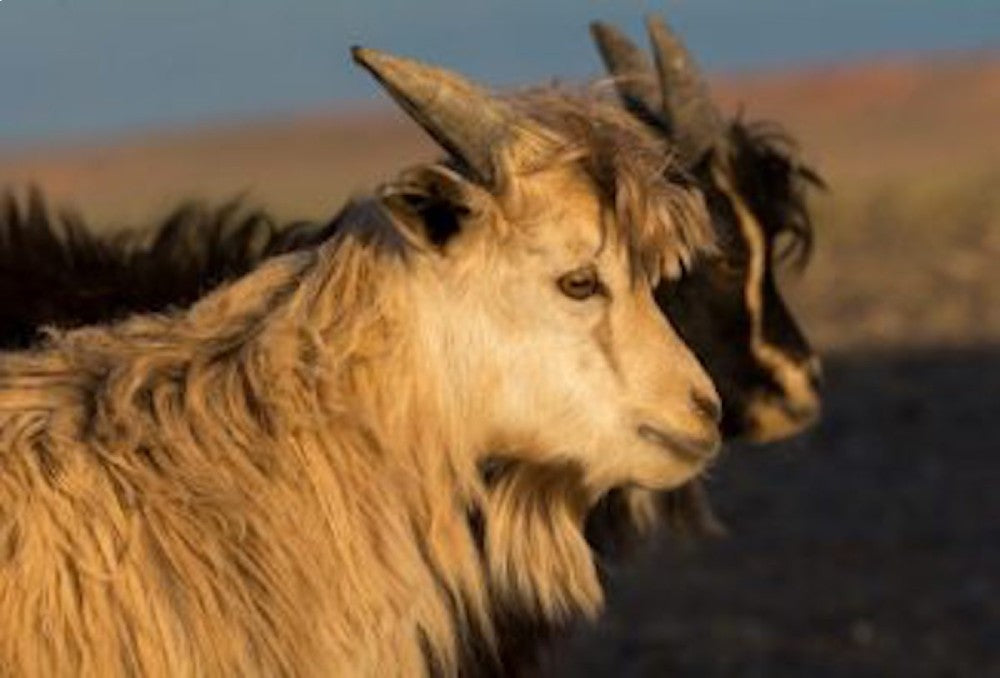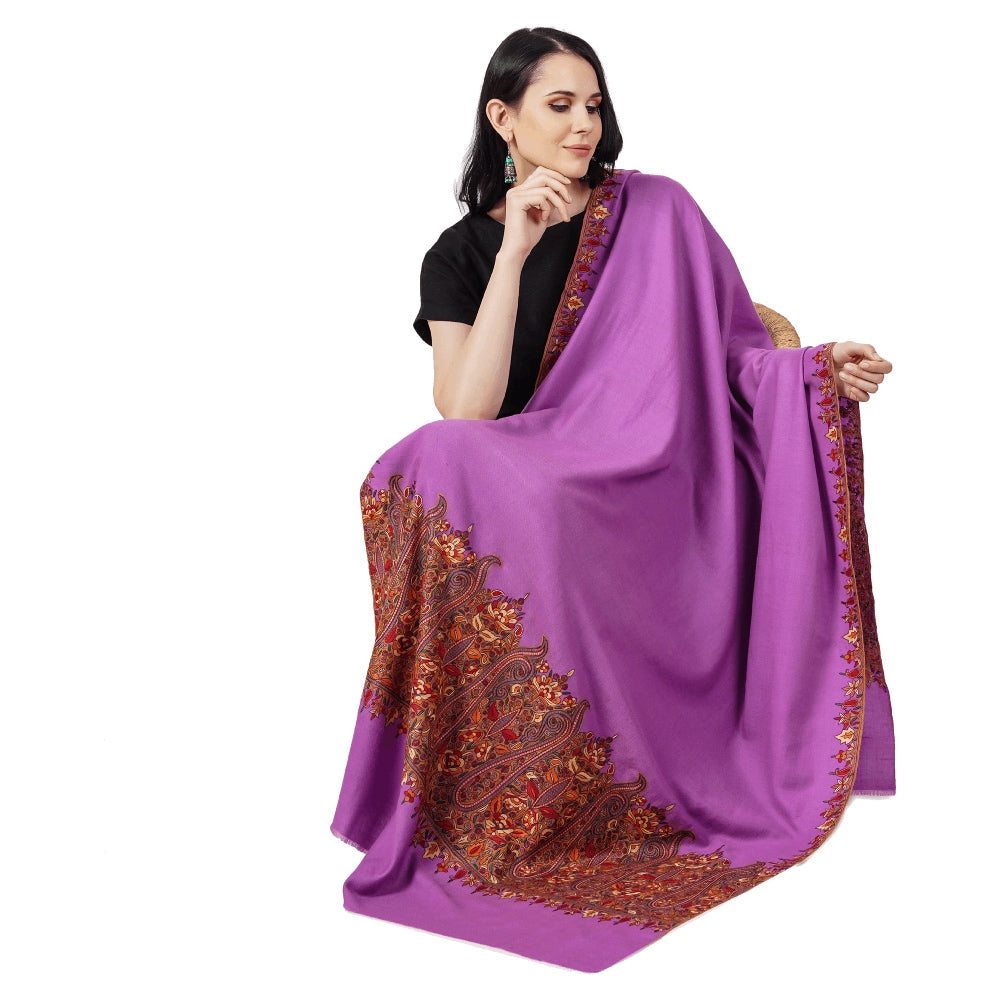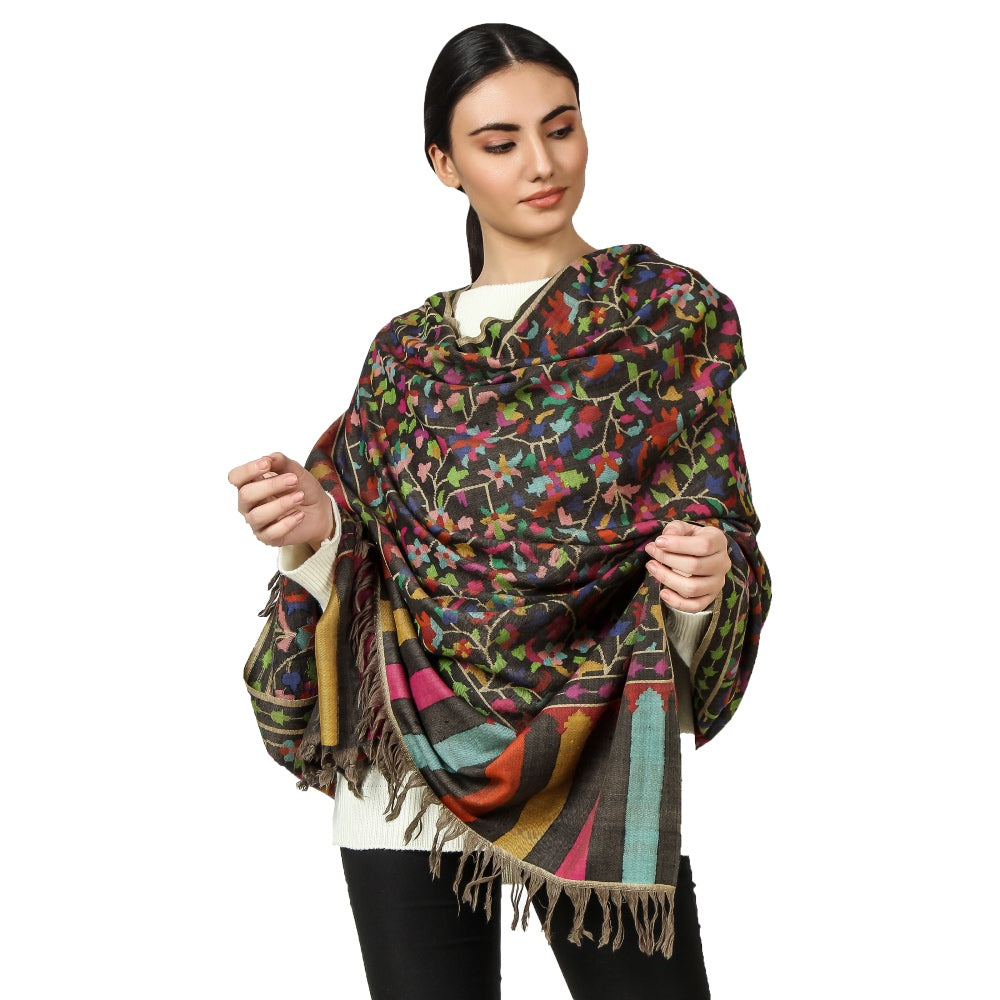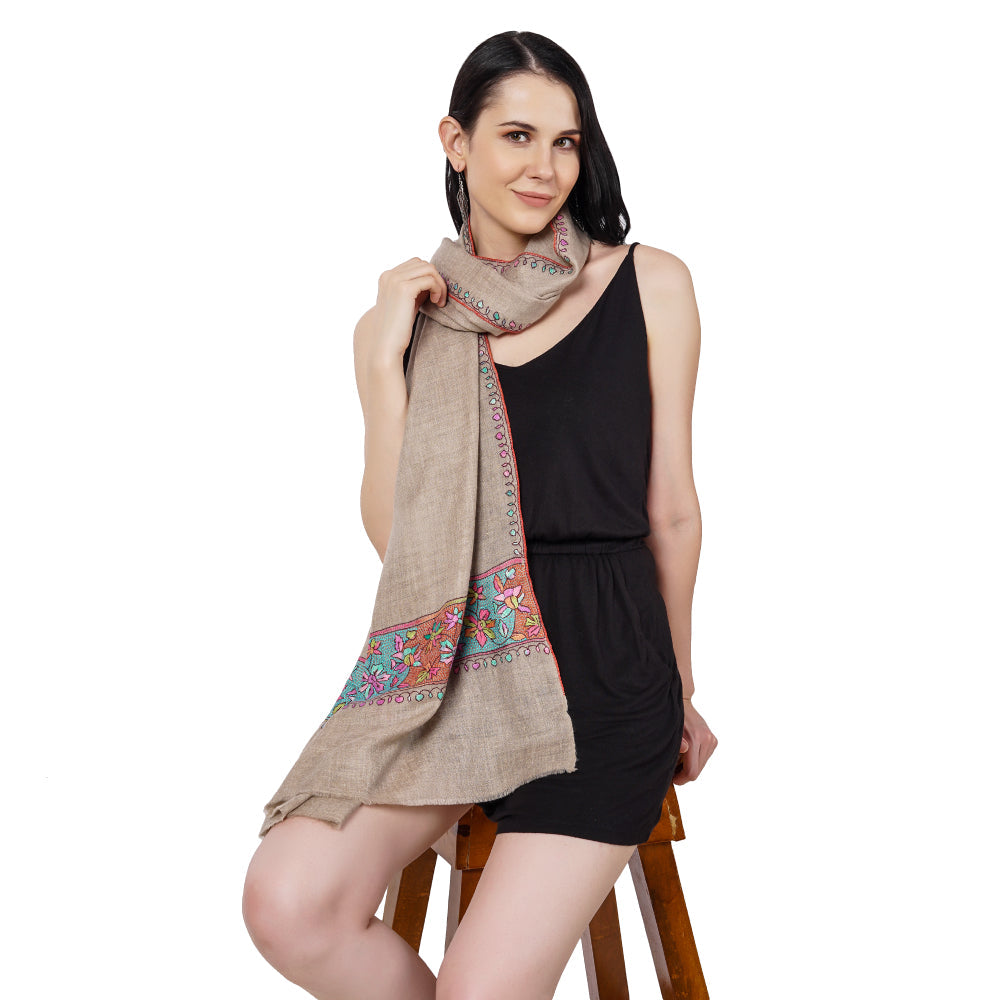
Which Animal wool is used for Pashmina Shawl?
Share
What is Pashmina?
A Pashmina shawl is a luxurious type of shawl made from the fine wool of the Pashmina goat. These shawls are known for their warmth, softness, and lightweight texture, making them highly coveted by people all around the world. Pashmina shawls are traditionally woven by skilled artisans in the Kashmir region of India and are often associated with royalty and high-end fashion.
Pashmina shawls have a rich history and cultural significance that dates back centuries. These shawls were once exclusive to the royal families of India, and were considered a symbol of wealth and power. Pashmina shawls were also exchanged as diplomatic gifts between rulers, further cementing their status as luxury items. Over time, Pashmina shawls became more widely available, and their popularity spread throughout the world. Today, Pashmina shawls are still highly valued for their beauty, quality, and cultural significance.

Pashmina shawls are considered rare and luxurious because of the high quality of their wool and the intricate craftsmanship required to produce them. Pashmina wool is obtained from the underbelly of the Pashmina goat, which is only found in the high-altitude regions of the Himalayas. The goats are shorn only once a year, and each animal produces only a small amount of wool, making Pashmina wool one of the rarest and most expensive fibers in the world. Additionally, the production of Pashmina shawls is a time-intensive and labor-intensive process that requires skilled artisans to weave the wool into intricate patterns and designs. As a result, Pashmina shawls are often considered a luxury item that only a select few can afford.
Also read: What is Pashmina Cashmere?
Understanding Pashmina Wool
A. What is Pashmina Wool?

Pashmina wool is a type of wool that comes from the undercoat of the Pashmina goat, which is found primarily in the Himalayan region of northern India, Nepal, and Pakistan. The wool is known for its fine, soft, and lightweight texture, making it a popular material for high-end clothing and accessories such as shawls, scarves, and blankets.
B. The Different Grades of Pashmina Wool

Pashmina wool is graded based on its thickness, softness, and overall quality. The highest grade of Pashmina wool is known as "kashmir," which is obtained from the underbelly of the goat and is the softest and most luxurious of all the grades. The next grade is "kasturi," which is obtained from the neck and shoulders of the goat and is slightly thicker and less soft than kashmir. The lowest grade is known as "rek," which is obtained from the legs and is the thickest and least soft of all the grades.
C. The Properties of Pashmina Wool
Pashmina wool has several unique properties that make it highly desirable. Firstly, it is incredibly warm and lightweight, making it perfect for cold weather clothing and accessories. Additionally, Pashmina wool is hypoallergenic, which means that it is unlikely to cause an allergic reaction in people with sensitive skin. Pashmina wool is also known for its durability and resistance to pilling, which is the formation of small balls or knots on the surface of the fabric.
D. How Pashmina Wool is Collected
Pashmina wool is collected from the Pashmina goat through a process called "combing." During the spring season, when the goat naturally sheds its undercoat, the wool is carefully combed from the goat's underbelly and collected in small batches. The collected wool is then carefully washed, carded, and spun into yarn before being woven into fabrics such as shawls and scarves. Because Pashmina goats only produce a small amount of wool each year, the production of Pashmina wool is both time-intensive and labor-intensive, making it a rare and valuable commodity.
Also read: Where does Pashmina come from?
Which Animal Produces Pashmina Wool?
A. The Difference Between Pashmina and Cashmere
Pashmina and cashmere are often used interchangeably, but they are actually two different types of wool. While Pashmina wool comes specifically from the undercoat of the Pashmina goat, cashmere wool comes from the undercoat of various breeds of goats, including the Changthangi and Chyangra goats found in the Himalayan region. Pashmina wool is also known for its fine, lightweight texture and is typically more expensive than cashmere.
B. The Species of Goats That Produce Pashmina Wool
The Pashmina goat, also known as the Changthangi goat, is the primary species of goat that produces Pashmina wool. These goats are found in the high-altitude regions of northern India, Nepal, and Pakistan, where they are well-adapted to the cold and harsh weather conditions. The goats have a thick, woolly undercoat that provides them with insulation against the cold, and it is this undercoat that is collected and used to make Pashmina wool.
C. The Characteristics of Pashmina-Producing Goats
Pashmina goats are small in size and have a slender build, with a distinctive hump at the base of their necks. They have a double coat, with a soft, fine undercoat and a coarser outer coat that provides protection against the elements. The undercoat of the Pashmina goat is highly valued for its softness, warmth, and fine texture, which make it ideal for making high-end clothing and accessories such as shawls and scarves.
D. The Distribution of Pashmina-Producing Goats
Pashmina goats are primarily found in the high-altitude regions of northern India, Nepal, and Pakistan. These regions are known for their cold and harsh weather conditions, which have contributed to the evolution of the Pashmina goat's thick and woolly undercoat. The goats are also well-adapted to the rugged terrain of the Himalayan mountains, where they are able to graze on sparse vegetation and survive in areas with limited resources. Due to their limited distribution and the labor-intensive process of collecting and processing their wool, Pashmina shawls and other products made from Pashmina wool are considered rare and luxurious.
Also read: Which goat breed produces Pashmina
IV. The Pashmina Shawl Industry
A. The Production Process of Pashmina Shawls
The production process of Pashmina shawls is highly labor-intensive and requires skilled artisans to produce high-quality products. The process typically involves collecting the wool from Pashmina goats during the spring shedding season, which is then sorted, cleaned, and spun into yarn. The yarn is then woven into fabric using traditional handloom techniques, with intricate designs and patterns often added through embroidery or weaving. The finished shawls are then washed and blocked to achieve the desired shape and size.
B. The Role of Artisans in the Pashmina Shawl Industry

Artisans play a critical role in the Pashmina shawl industry, with many of them belonging to the marginalized communities of Kashmir, India, and Nepal. They have inherited their skills from previous generations and use traditional techniques to create intricate designs and patterns on the shawls. Many artisans work from home or in small workshops, where they have access to the necessary equipment and materials. The Pashmina shawl industry provides employment opportunities to many artisans, who are able to earn a sustainable livelihood through their work.
C. The Challenges Faced by the Pashmina Shawl Industry
The Pashmina shawl industry faces several challenges, including the use of synthetic fibers and imitations, which are often sold at lower prices than authentic Pashmina shawls. This has resulted in a decrease in demand for authentic Pashmina shawls, leading to a decline in the number of artisans involved in the industry. Additionally, the Pashmina goat population has also been affected by overgrazing, deforestation, and climate change, which has resulted in a decrease in the availability of Pashmina wool.
D. The Future of the Pashmina Shawl Industry
The future of the Pashmina shawl industry depends on the preservation and promotion of authentic Pashmina shawls. Efforts are being made to raise awareness about the importance of authentic Pashmina shawls and the role of artisans in their production. Additionally, there is a need for sustainable and ethical practices in the industry, including the conservation of the Pashmina goat population and the use of environmentally-friendly production methods. Through these efforts, the Pashmina shawl industry can continue to thrive and provide sustainable employment opportunities to artisans while preserving a valuable cultural heritage.
Also read: The reign of Heirloom Pashmina
The Ethics of Pashmina Production
A. The Impact of Pashmina Production on the Environment
The production of Pashmina wool has a significant impact on the environment, particularly in the regions where Pashmina goats are raised. The goats require large areas of grazing land, and overgrazing can lead to soil erosion and the destruction of natural habitats. Additionally, the process of washing and dyeing Pashmina wool can also have negative effects on water sources, leading to pollution and depletion of water resources. To address these concerns, sustainable and environmentally-friendly production practices are needed in the Pashmina industry.
B. The Welfare of Pashmina-Producing Goats
The welfare of Pashmina-producing goats is also an important ethical concern in the Pashmina industry. Goats that are used for their wool should be treated humanely and provided with adequate food, water, and shelter. Practices such as tail docking and dehorning should be avoided, as they can cause pain and distress to the animals. Additionally, goats should be allowed to graze in natural environments and not be subjected to intensive farming practices that prioritize wool production over animal welfare.
C. The Importance of Ethical and Sustainable Pashmina Production
Ethical and sustainable Pashmina production is important not only for the welfare of Pashmina goats but also for the long-term viability of the industry. Consumers are increasingly interested in ethically-produced products and are willing to pay a premium for items that are produced sustainably and humanely. By adopting ethical and sustainable production practices, the Pashmina industry can ensure that it meets the demands of consumers while also preserving the natural environment and supporting the livelihoods of artisans and Pashmina goat farmers.
How to Care for Your Pashmina Shawl
A. Washing and Drying Your Pashmina Shawl
Pashmina shawls are delicate items that require special care to ensure they last a long time. When it comes to washing your Pashmina shawl, it is best to avoid using a washing machine or dryer, as these can damage the delicate fibers. Instead, hand washing is recommended. Fill a basin with cold water and add a mild detergent, such as wool wash. Gently swirl the shawl in the water, being careful not to agitate or rub the fibers too much. Rinse the shawl in cold water until all soap is removed. Do not wring or twist the shawl. Instead, gently press it to remove excess water and lay it flat to dry.
B. Storing Your Pashmina Shawl
Proper storage is also important to keep your Pashmina shawl in good condition. It is best to store it in a cool, dry place, away from direct sunlight and sources of heat. Folding is recommended over hanging to prevent stretching or misshaping. Avoid storing your Pashmina shawl with mothballs, as these can damage the delicate fibers. Instead, use cedar balls or lavender sachets to deter moths and other pests.
C. Dealing with Pilling and Other Issues
Pashmina shawls can develop small balls of fuzz on the surface, known as pilling. To remove pilling, use a fabric shaver or a razor blade to carefully shave off the pills. Be careful not to cut the fibers, as this can damage the shawl. If your Pashmina shawl develops any stains or spots, it is best to have it professionally cleaned to avoid damaging the delicate fibers. Additionally, avoid exposing your Pashmina shawl to harsh chemicals, such as bleach or fabric softeners, which can damage the fibers and affect the softness of the shawl.
VII. Frequently Asked Questions
A. What is the Difference Between Pashmina and Cashmere?
Pashmina and cashmere are often used interchangeably, but they are not the same thing. Pashmina refers specifically to the wool that comes from the underbelly of the Capra hircus goat, which is found in the Himalayan region. Cashmere, on the other hand, refers to the wool that comes from the Cashmere goat, which is found in Central Asia. While both Pashmina and cashmere are known for their softness and warmth, Pashmina is considered to be the more luxurious and rare of the two.
B. Are Pashmina Shawls Warm?
Yes, Pashmina shawls are very warm. The unique properties of Pashmina wool make it ideal for keeping the body warm in cold temperatures. The fibers are thin and lightweight, but they are also highly insulating, which means they can trap heat close to the body. Pashmina shawls are also breathable, which allows for air flow and prevents overheating.
C. How Can I Tell if a Pashmina Shawl is Authentic?
Authentic Pashmina shawls are made from the wool of the Capra hircus goat, which is only found in the Himalayan region. They are also hand-woven and hand-embroidered by skilled artisans. To determine if a Pashmina shawl is authentic, look for the label or tag, which should indicate that it is made from 100% Pashmina wool. The shawl should feel soft and lightweight, and it should have a distinctive sheen to it. You can also perform a burn test by burning a small piece of the shawl. If it burns slowly and smells like hair, it is likely authentic Pashmina.
D. How Do I Know if a Pashmina Shawl is of Good Quality?
The quality of a Pashmina shawl can be determined by a few factors. First, the softness and warmth of the shawl are important indicators of quality. The shawl should feel soft and luxurious to the touch, and it should provide ample warmth. The fineness of the fibers is also an important factor. The higher the grade of Pashmina wool, the finer the fibers will be, which results in a softer and more lightweight shawl. Finally, the craftsmanship of the shawl is important. Look for hand-woven and hand-embroidered shawls, which are often considered to be of higher quality than machine-made shawls.
E. What Are the Best Ways to Style a Pashmina Shawl?
Pashmina shawls can be styled in a variety of ways, making them a versatile accessory for any wardrobe. One popular way to wear a Pashmina shawl is to drape it over the shoulders and let it hang loose. This is a classic and elegant look that is perfect for formal occasions. You can also wrap the shawl around your neck like a scarf for a more casual look. For a more dramatic look, you can fold the shawl in half and drape it over your head, using a brooch to keep it in place. Pashmina shawls also make great travel accessories, as they can be used as blankets or pillows on long flights.








